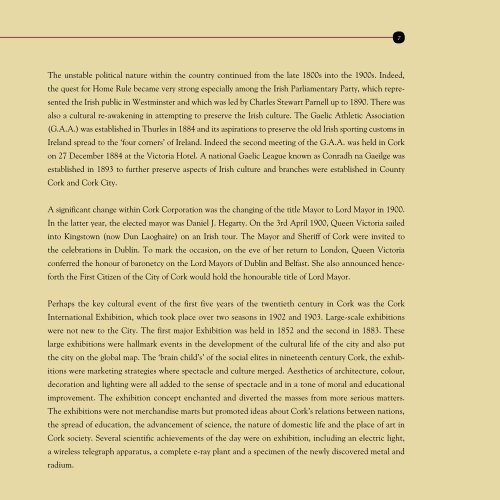M&P O'Sullivan Ltd 100 Years
You also want an ePaper? Increase the reach of your titles
YUMPU automatically turns print PDFs into web optimized ePapers that Google loves.
7<br />
The unstable political nature within the country continued from the late 1800s into the 1900s. Indeed,<br />
the quest for Home Rule became very strong especially among the Irish Parliamentary Party, which represented<br />
the Irish public in Westminster and which was led by Charles Stewart Parnell up to 1890. There was<br />
also a cultural re-awakening in attempting to preserve the Irish culture. The Gaelic Athletic Association<br />
(G.A.A.) was established in Thurles in 1884 and its aspirations to preserve the old Irish sporting customs in<br />
Ireland spread to the ‘four corners’ of Ireland. Indeed the second meeting of the G.A.A. was held in Cork<br />
on 27 December 1884 at the Victoria Hotel. A national Gaelic League known as Conradh na Gaeilge was<br />
established in 1893 to further preserve aspects of Irish culture and branches were established in County<br />
Cork and Cork City.<br />
A significant change within Cork Corporation was the changing of the title Mayor to Lord Mayor in 1900.<br />
In the latter year, the elected mayor was Daniel J. Hegarty. On the 3rd April 1900, Queen Victoria sailed<br />
into Kingstown (now Dun Laoghaire) on an Irish tour. The Mayor and Sheriff of Cork were invited to<br />
the celebrations in Dublin. To mark the occasion, on the eve of her return to London, Queen Victoria<br />
conferred the honour of baronetcy on the Lord Mayors of Dublin and Belfast. She also announced henceforth<br />
the First Citizen of the City of Cork would hold the honourable title of Lord Mayor.<br />
Perhaps the key cultural event of the first five years of the twentieth century in Cork was the Cork<br />
International Exhibition, which took place over two seasons in 1902 and 1903. Large-scale exhibitions<br />
were not new to the City. The first major Exhibition was held in 1852 and the second in 1883. These<br />
large exhibitions were hallmark events in the development of the cultural life of the city and also put<br />
the city on the global map. The ‘brain child’s’ of the social elites in nineteenth century Cork, the exhibitions<br />
were marketing strategies where spectacle and culture merged. Aesthetics of architecture, colour,<br />
decoration and lighting were all added to the sense of spectacle and in a tone of moral and educational<br />
improvement. The exhibition concept enchanted and diverted the masses from more serious matters.<br />
The exhibitions were not merchandise marts but promoted ideas about Cork’s relations between nations,<br />
the spread of education, the advancement of science, the nature of domestic life and the place of art in<br />
Cork society. Several scientific achievements of the day were on exhibition, including an electric light,<br />
a wireless telegraph apparatus, a complete e-ray plant and a specimen of the newly discovered metal and<br />
radium.


